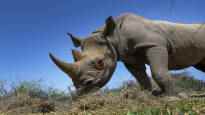The situation of the Sumatran rhinoceros is grim and the second subspecies of the big rhinoceros is already practically extinct.
23.8. 16:31•Updated 23.8. 16:42
80 percent of all the world’s rhinos live in South Africa, and the animals there are especially concentrated in the Kruger National Park.
The biggest threat to rhinos is illegal hunting. That also happens the most in Kruger Park. However, hunting is decreasing.
According to the IUCN, 5.3 percent of the world’s rhino population was lost due to poaching in 2015. In 2021, the share had fallen to 2.3 percent.
This is because control has improved and the demand for products made from rhinoceros has decreased. In 2020, poaching decreased exceptionally much due to corona restrictions.
The big rhinoceros has the largest population
The most common rhinoceros is the big rhinoceros, whose number decreased by about two thousand between 2018 and 2021. Now there are about 16,000 of them. The big rhinoceros is classified as “endangered”.
The big rhinoceros is divided into two subspecies, the more common of which is the southern broad-lipped rhinoceros. Another subspecies, the Zaire wide-lipped rhinoceros, has only two females left. The subspecies is therefore practically extinct.
Another of the African rhinos, the bush rhinoceros, is doing better. Its stock rose by about 12 percent in four years. Now there are about 6,200 of them. The bush rhinoceros is still classified as “very endangered”.
Asian rhinos have a worse situation. The population of the Indian rhinoceros living in India and Nepal has been increased by about 400 individuals to more than 4,000.
The number of Javan rhinoceros living on the island of Java in Indonesia increased by about ten during the research period, and there are now 76. The animal is still extremely endangered.
The Sumatran rhinoceros is in the worst trouble. The IUCN estimates their number to be only 34–47. According to the estimate of the environmental organization WWF, there are almost 80 animals that hide in the wild. It is comforting that, according to the IUC’s data, sumatra rhinos have not been hunted in recent years.
According to the IUCN, the prerequisite for the survival of rhinos is continuous conservation work and prevention of poaching.
Change in the number of rhinos 2018–2021
species of rhinoceros | amount in 2018 | amount in 2021
big rhinoceros 18,067 | 15,942
bush rhino around 5,450 | 6,195
Indian Rhinoceros 3,588 | 4,014
Javan rhinoceros 65–68 | 78
Sumatran rhinoceros 40–78 | 34–47
